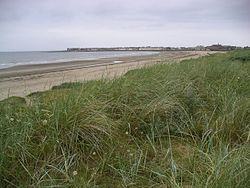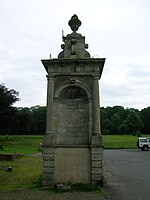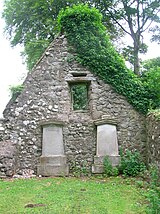Troon
| Troon | |
| Ayrshire | |
|---|---|

| |
| Location | |
| Grid reference: | NS345255 |
| Location: | 55°32’24"N, 4°39’36"W |
| Data | |
| Population: | 14,766 |
| Post town: | Troon |
| Postcode: | KA10 |
| Dialling code: | 01292 |
| Local Government | |
| Council: | South Ayrshire |
| Parliamentary constituency: |
Central Ayrshire |
Troon is a town in Ayrshire. It is situated on the west coast, about eight miles north of Ayr and three miles northwest of Glasgow Prestwick International Airport, opposite the Isle of Arran. Troon is also a port with freight and ferry services — the P&O Express to Larne and a yacht marina. In May 2006, a ferry service to Campbeltown was added.
Contents
Fullarton House
Fullarton House was built by William Fullarton of that Ilk in 1745 and altered by his son, however it was demolished in 1966 by the council who had been unable to maintain the building after purchasing it in 1928.
The entrance route had been changed by the Duke of Portland and the house design altered so that the back became the front, with grand views opened up of the Isle of Arran and Firth of Clyde.[1] After centuries of occupation the Fullarton lines possession had thus come to an end when the Duke of Portland purchased the property in 1805. He lived here for a while as his principal residence in Scotland, however he had a greater interest in developing Troon harbour and the Kilmarnock and Troon Railway.
The grounds are now a park with some signs of the old house still apparent, such as the magnificent stable block, the ornamental pediments, walled gardens, dovecot and an ice house.[2]
The Fullarton family
The name is thought to come from the office of 'Fowler to the King', the purpose of which was to supply wild-fowl to the King as required. The dwelling which came with the post was called Fowlertoun and the family may have eventually adopted the name. The Fullarton's of Angus had been required by Robert I to supply him with wild-fowl at his castle of Forfar.[1]
Alanus de Fowlertoun was in possession of the lands shortly before his death in 1280 and the family continued in a nearly unbroken line from father to son. William Fullarton, the builder of the house, inherited the estate from his grandfather in 1710, he having inherited it from his brother in turn. Colonel Fullarton died in 1808, the last Fullarton of that Ilk laird.[1] He wrote in 1793 the seminal A General View of the Agriculture in the County of Ayr and was one of the few on record to praise Robert Burns's skills as a farmer, commenting favourably on a method of dishorning cattle which the poet had demonstrated. Burns is said to have visited Fullarton.[3]
The Fullarton grotto and stables
The Robert Adam designed Fullarton stables.
Crosbie Castle
Robert II granted the old Crosbie estate to the Fullartons in 1344 and by the 18th century the old castle was partly demolished and converted into an ice house for Fullarton House, with a dovecot nearby.[2] In 1969 more of the ice house was demolished to make it safe. The building had been known as Crosby Place and later became Fullarton House, not long before the new building of the same name replaced it.[1]
Over the centuries the castle was rebuilt three times, in the same typical square design as seen at Dundonald Castle. The remains today mainly represent the Castle's dungeon. Many of Crosbie Castle's stones were used in the construction of the first Fullarton House. The dungeon, had an underground stream, making it the ideal cold storage cellar or ice house.[4]
Crosbie church and cemetery
First recorded in 1229, the present structure dates from 1691. Tradition claims that the roof blew off on the day in 1759 that Robert Burns was born and it was left to become a ruin. One of the graves is that of David Hamilton of Bothwellhaugh, son of, James, alleged assassin of the Regent Moray, bastard son of James V. This event occurred in 1570 and David died in 1619. David Fullarton of that Ilk had married David's sister.[2]
Constructed on the site of the original chapel, the name comes from the Anglo-Saxon word 'Crossbye', signifying the dwelling of the cross; a fairly common placename. The cemetery dates from circa 1240 and was held in secular times by Fullarton of Crosbie in the 14th century after being passed on from relatives. Records indicate that this ground was used by a holy order before the Fullartons arrived in the area.[4] The chapelry of Crosbie, together with that of Richardstoun (Riccartoun) were attached to Dundonald and were granted by the second Walter Stewart to the short lived Gilbertine Convent which he had founded at Dalmulin in 1238. The convent was disestablished in 1238 and the chapel passed to the monks of Paisley Abbey.[5]
The cemetery was the burial ground for Troon until 1862 and family lairs were still in use until after the First World War. One the other side of the road, the remains of the church manse can still be seen (2009). The 'Wrack Road' was the Fullarton Estate estate road used by tenants who took their carts down to the shore to collect seaweed or wrack as fertilizer and it was the main road from Troon for funerals going to Crosbie.[4]
Janet McFadzean was buried in Crosbie cemetery in 1761 and the front of her tombstone reads: Here lyes the corps of Janet McFadzean, Spous of William McFadzean, Quarter-Master Sergean in Lovetenan General Homs Regiment of Sol., who died August 22, 1761, aged 27 years.
The reverse side reads:
Twenty-four years i lived a maiden life,
And three years i was a married wife,
In which time i lived a hapie life,
I trevld with him from toun to toun,
Until by death i was cut down.
In my sister's hous did die,
And here at Crosbie Kirk i ly,
Where i my rest and sleep will take,
Until at last i be awaked.
It will not be with tuk of drum,
But it will be when the trumpet sound,
And while ile my Redeemer see,
Who shed his preshios blood for me.
Views of the cemetery
References
Sources
- Blair, Anna (1983). Tales of Ayrshire. London : Shepeard - Walwyn. ISBN 0-85683-068-2.
- Dougall, Charles S. (1911). The Burns County. London: A & C Black.
- Love, Dane (2003), Ayrshire: Discovering a County. Ayr: Fort Publishing. ISBN. 0-9544461-1-9.
- Millar, A. H. (1885). The Castles and Mansions of Ayrshire. Glasgow : Grimsay Press. ISBN 1-84530-019-X.
- Paterson, James (1863-66). History of the Counties of Ayr and Wigton. V. - II - Kyle. Edinburgh: J. Stillie.













